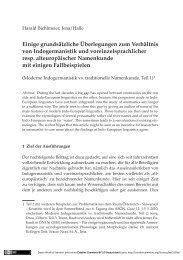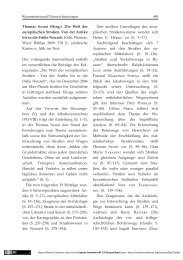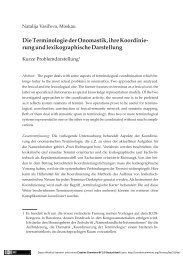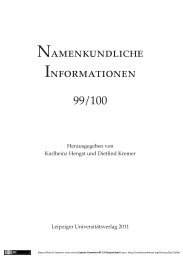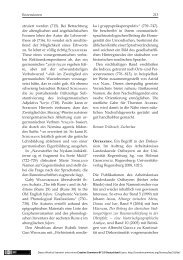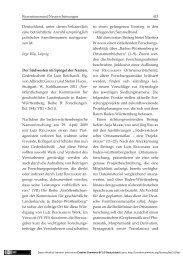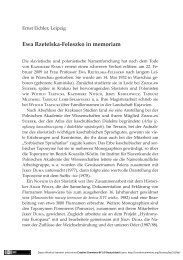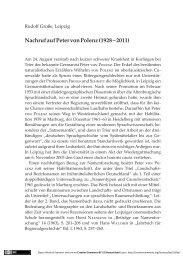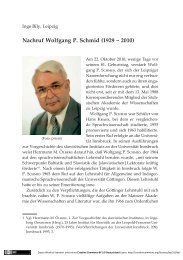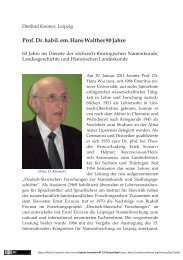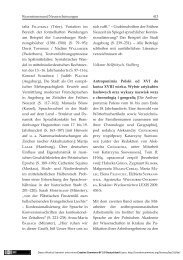Proper Names in the Light of Theoretical Onomastics
Proper Names in the Light of Theoretical Onomastics
Proper Names in the Light of Theoretical Onomastics
You also want an ePaper? Increase the reach of your titles
YUMPU automatically turns print PDFs into web optimized ePapers that Google loves.
<strong>Proper</strong> <strong>Names</strong> In <strong>the</strong> <strong>Light</strong> <strong>of</strong> <strong>Theoretical</strong> <strong>Onomastics</strong>117short”), Dollároš (“ he was <strong>in</strong> America”). For surnames, <strong>the</strong> feature <strong>of</strong> expressivenessrefers to <strong>the</strong> form <strong>of</strong> <strong>the</strong> name; for un<strong>of</strong>ficial names <strong>the</strong> livemotivation refers to <strong>the</strong> person named. A characteristic group <strong>of</strong> liv<strong>in</strong>gnames is forms with overt expressiveness (Čunčo, Čirbirák, Frťko, Grňa,Lizák, Harajda, Trlaj, Kič<strong>in</strong>a, Škadra, Huka etc.).9. 〈Group<strong>in</strong>g〉 has a special status among o<strong>the</strong>r onymic features s<strong>in</strong>ce itis closely related to <strong>the</strong> anthroponymic feature 〈family affiliation〉 or <strong>the</strong>chrematonymic feature 〈serial〉. If it is related to <strong>the</strong> feature 〈family affiliation〉,a name demonstrates relatives with<strong>in</strong> a family, <strong>in</strong>clud<strong>in</strong>g members<strong>of</strong> k<strong>in</strong>ship groups. In German, <strong>the</strong>se names are termed Gruppennamen.They have a plural form and <strong>in</strong> Slovak <strong>the</strong>y are formed by <strong>the</strong> suffix-ovci (Kubala – Kubalovci, Rybár – Rybárovci ). However, <strong>the</strong> adherents,followers, or scholars <strong>of</strong> a person named by his or her proper name areclassified as appellatives (and <strong>the</strong>ir <strong>in</strong>itial letter is written <strong>in</strong> lower case:bernolákovci, štúrovci) s<strong>in</strong>ce <strong>the</strong> features “follower, adherent, scholar” donot predicate <strong>the</strong> family affiliations which are relevant to <strong>the</strong> category <strong>of</strong>personal names. <strong>Names</strong> <strong>in</strong> which 〈group<strong>in</strong>g〉 is comb<strong>in</strong>ed with <strong>the</strong> feature〈serial〉 belong to ano<strong>the</strong>r subsystem. This is a rich class <strong>of</strong> chrematonymswhich <strong>in</strong>cludes various k<strong>in</strong>ds <strong>of</strong> products made <strong>in</strong> series, such as newspapers,magaz<strong>in</strong>es, books (Pravda, Slovenka, Dom v stráni), names <strong>of</strong> means<strong>of</strong> urban transport (cars, bicycles, tra<strong>in</strong>s, boats), clean<strong>in</strong>g and chemists’pro ducts etc. However, <strong>the</strong> names <strong>of</strong> some commonly used products (with<strong>the</strong> <strong>in</strong>itial letter written <strong>in</strong> lower case) such as rizl<strong>in</strong>g – Riesl<strong>in</strong>g, rokfort –Roquefort, kuba – Havana cigar, mercedes and especially names derived fromnames <strong>of</strong> patented products by suffixation (e. g. fiatka – Fiat car, škodovka –Škoda car, tatramatka – wash<strong>in</strong>g mach<strong>in</strong>e) are classified as appellatives.The reflection <strong>of</strong> <strong>the</strong> content elements <strong>of</strong> a proper name <strong>in</strong> its languageform confirms <strong>the</strong> perception <strong>of</strong> <strong>the</strong> proper name as a b<strong>in</strong>ary onymic sign.2. 5 Modell<strong>in</strong>g <strong>in</strong> onomastics. On <strong>the</strong> beg<strong>in</strong>n<strong>in</strong>g <strong>of</strong> modell<strong>in</strong>g <strong>of</strong> propernamesThe concept <strong>of</strong> modell<strong>in</strong>g <strong>the</strong> nam<strong>in</strong>g act and also modell<strong>in</strong>g <strong>the</strong> wholeset <strong>of</strong> onymic elements <strong>of</strong> a given class generalises proprial nam<strong>in</strong>gpr<strong>in</strong>ci ples and leads to comprehend<strong>in</strong>g and depict<strong>in</strong>g proprial relations,elements and <strong>the</strong>ir <strong>in</strong>ternal organisation <strong>in</strong> <strong>the</strong>ir deep structure (see alsoŠrámek 1999). Supra-<strong>in</strong>dividual hierarchised features (onosemes, functions)embedded <strong>in</strong> social standards and needs have <strong>the</strong> most general



